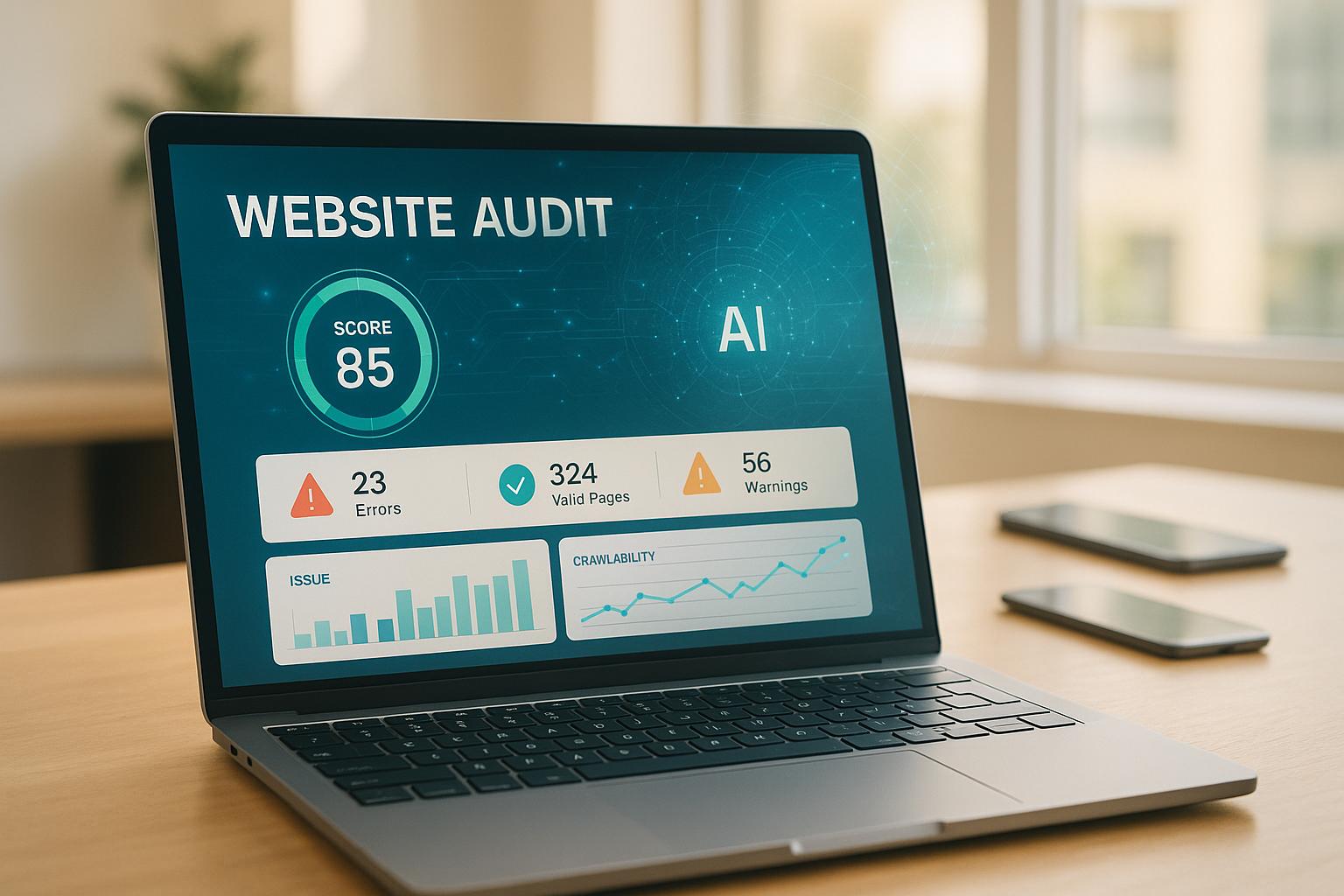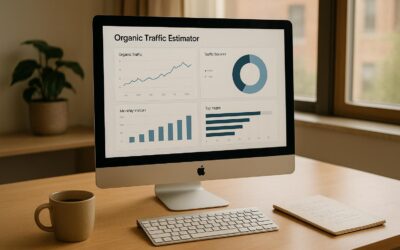Google’s March 2025 Core Update caused a 63% spike in SERP fluctuations, shaking up rankings across industries. Websites with outdated technical SEO practices saw major traffic drops, while mobile-friendly, secure, and fast-loading sites thrived.
Here’s what’s new and important in 2025:
- Core Web Vitals 2.0: New metrics like Interaction to Next Paint (INP) and visual stability are now critical for rankings.
- Mobile-Only Indexing: Google fully transitioned to mobile-first indexing – your mobile site determines your rankings.
- AI-Powered Crawler: Google’s new GeminiBot evaluates user intent and site functionality better than ever.
- E-E-A-T Focus: Experience, Expertise, Authoritativeness, and Trustworthiness matter more, especially for content quality.
Key Takeaways:
- Speed and User Experience: Optimize for fast loading, smooth navigation, and mobile usability.
- Structured Data: Use schema markup to help Google understand and rank your content.
- Security and Accessibility: HTTPS and features like voice search compatibility are now ranking factors.
Technical SEO is no longer optional. It’s the foundation for maintaining rankings and adapting to Google’s evolving algorithms.
Technical SEO Is Back: What E-Commerce Brands Need to Know in 2025
Key Changes in 2025 Core Algorithm Updates
The 2025 core updates mark a shift toward creating search experiences that cater directly to user needs. These updates revolve around three main priorities: ensuring content reliability, improving technical performance, and leveraging AI for content evaluation. To maintain or improve search rankings, it’s crucial to align with these evolving standards.
The March 2025 update had a noticeable impact across various industries, with clear winners and losers depending on how well they adapted to Google’s new focus areas.
| Industry | Winners | Losers | Takeaway |
|---|---|---|---|
| Forums | Reddit (+22% visibility) | DIYChatroom (-70% traffic) | Focus on genuine user-driven discussions rather than keyword-heavy posts. |
| E-commerce | Uniqlo (+76% visibility) | Bluettipower.com (-55%) | Thin, automated product pages are now penalized. |
| Government | USA.gov (+34%) | HMRC.gov.uk (-52%) | Trustworthiness and HTTPS compliance are essential. |
These trends highlight Google’s preference for content that offers real value to users. The update underscores the importance of aligning technical and content strategies, which will be explored further in later sections.
Focus on E-E-A-T and Content Quality
Google’s commitment to Experience, Expertise, Authoritativeness, and Trustworthiness (E-E-A-T) has intensified in 2025. The algorithm now places even greater importance on experience and subject-matter expertise. Websites must demonstrate deep knowledge and credibility to remain competitive.
This shift means technical improvements alone aren’t enough – content must also meet high standards of quality and relevance. Google’s updates target material that lacks expertise or fails to offer meaningful value. High-performing websites consistently align their content with user intent while regularly updating and optimizing their pages. A long-term approach to improving content is no longer optional; it’s a necessity for staying visible in search results.
Sites that clearly identify authorship, reference reliable sources, and deliver unique, firsthand insights consistently outperform those with generic or poorly researched material.
Core Web Vitals and User Experience Requirements
In early 2025, Google introduced Core Web Vitals 2.0, raising the bar for technical performance. These updated metrics emphasize visual stability and interaction predictability, broadening the focus from speed alone to overall user experience.
As search behavior evolves, delivering fast, engaging, and seamless digital experiences is more important than ever.
Mobile usability remains a cornerstone of SEO success. Fully responsive and accessible websites rank better, as they cater to users on mobile devices. Additionally, maintaining HTTPS security, supporting voice search, and ensuring screen-reader compatibility build trust and improve site performance.
Google’s AI-driven ranking models now provide deeper insights into how technical issues impact user experience. This makes staying on top of technical SEO requirements an ongoing priority.
AI-Driven Search Evaluations
AI continues to reshape how Google evaluates content, with machine learning models offering more sophisticated assessments of quality and relevance. These models better match content to user search queries, leading to more refined rankings.
One notable change is the rise of AI Overviews. In March 2025, 13.14% of search queries triggered AI Overviews, up from 6.49% in January. This feature now reaches 1.5 billion users monthly, reflecting Google’s increased reliance on trusted sources and authoritative content.
As AI-driven ranking systems evolve, they adapt to shifts in user behavior and expectations. With users asking more complex, nuanced questions, websites must prioritize offering unique insights – whether through personal experience, original research, or expert analysis. By blending traditional SEO techniques with AI-friendly content structures and strong authority signals, businesses can stay competitive in this changing landscape.
Technical SEO Changes for Core Update Compliance
Preparing for Google’s 2025 core updates means making precise technical adjustments that prioritize performance, mobile usability, and structured data. These changes are essential to align with the algorithm’s focus on user experience and content quality. A great place to start is by improving site speed, a key factor in Core Web Vitals.
How to Improve Site Speed and Core Web Vitals
Google’s Core Web Vitals 2.0 has upped the ante for website performance. The three main metrics – Largest Contentful Paint (LCP), Interaction to Next Paint (INP), and Cumulative Layout Shift (CLS) – are now central to how Google evaluates user experience.
By May 2024, only 62.1% of websites met the LCP standard, and nearly 600,000 websites failed the Core Web Vitals test following the switch from First Input Delay to INP in March 2024. These changes present both challenges and opportunities for businesses aiming to boost their rankings.
Optimizing Largest Contentful Paint (LCP) focuses on speeding up page load times. This includes cutting unnecessary third-party scripts, avoiding lazy loading for above-the-fold content, upgrading hosting to reduce server delays, and using the fetchpriority attribute for key images. Other strategies include inlining critical CSS, preloading essential resources, serving critical assets from the same domain, and implementing 103 Early Hints to help browsers load resources faster.
Improving Interaction to Next Paint (INP) requires better responsiveness to user actions. Key steps include deferring non-critical JavaScript, removing unneeded third-party scripts, splitting large JavaScript files into smaller pieces, and reducing the size of the DOM.
Reducing Cumulative Layout Shift (CLS) minimizes visual disruptions. To achieve this, set size attributes for all images and videos, reserve space for ads, and avoid adding new content above the fold dynamically. Additionally, refine fallback fonts with CSS properties like size-adjust, ascent-override, and descent-override to prevent layout shifts during font loading.
Performance matters beyond rankings. Studies show 61% of customers will abandon a company if a competitor offers a better experience. These technical improvements not only meet Google’s standards but also directly impact customer retention.
Mobile Usability and Responsive Design Updates
Speed isn’t everything – your mobile experience must also shine. With Google’s mobile-first indexing, your mobile site determines your search rankings. A seamless mobile experience is non-negotiable, especially since 40% of users will leave for a competitor if navigation is difficult.
Mobile-First Design Implementation means ensuring your mobile content mirrors your desktop version. This includes identical structured data, metadata, and internal links. Consistent H1–H6 tags across devices are also crucial, and Googlebot must have full access to your CSS, JavaScript, and images.
Touch-Friendly Interface Design involves making tap targets at least 48 pixels in size, with 32 pixels of spacing around them. Since 94% of users browse in portrait mode, prioritize vertical layouts, make the home button prominent, and avoid tricky drop-down menus.
Page Speed Optimization on mobile is critical, as most users abandon pages that take more than 3 seconds to load. Optimize images, streamline code, and use CSS media queries to adapt layouts for various screen sizes.
Voice Search Optimization is becoming essential, with over 50% of internet searches now voice-based. Use conversational long-tail keywords and structured data to align with voice queries. For local businesses, this is especially important as 46% of Google searches are location-specific.
Adding Structured Data and Schema Markup
Performance and mobile usability are only part of the equation. Structured data helps search engines understand your content better, which can lead to higher visibility. Real-world examples show the benefits: Rotten Tomatoes added structured data to 100,000 pages and saw a 25% increase in click-through rates. The Food Network optimized 80% of its pages and gained a 35% boost in visits. Rakuten found users spent 1.5 times more time on pages with structured data, while Nestlé saw an 82% jump in click-through rates for rich results.
JSON-LD Implementation is Google’s preferred format for structured data. Choose the most specific schema type for your content, fill in all required properties, and ensure your markup matches the visible content.
Schema Markup Best Practices include keeping structured data up to date, avoiding markup for hidden content, and steering clear of misleading information or fake reviews. Focus on the main type of structured data that reflects your page’s purpose and ensure all items are complete.
Testing and Validation are essential. Use tools like Google’s Rich Results Test and the URL Inspection tool to confirm compliance. Regularly check Search Console for performance insights and potential issues.
"Google Search works hard to understand the content of a page. You can help us by providing explicit clues about the meaning of a page to Google by including structured data on the page."
– Google Search Central
For those looking to implement these technical SEO updates, SearchX’s technical SEO services offer expertise in Core Web Vitals, mobile usability, and structured data, ensuring your site stays ahead of 2025’s algorithm changes.
How to Monitor and Manage Ranking Changes
Keeping an eye on your search visibility after core updates is essential. In 2023 alone, Google made 4,781 changes to its search algorithms, making it critical to track your SERP performance and quickly identify any issues.
Tracking SERP Changes
Start with Google Search Console. It’s your go-to tool for understanding how core updates impact keyword positions. By comparing rankings before and after an update, you can pinpoint which pages were affected.
For real-time insights, tools like Semrush Sensor are invaluable. They monitor SERP volatility and help you differentiate between regular ranking shifts and more significant algorithm changes. Similarly, CognitiveSEO Signals tracks over 170,000 keywords daily across desktop, mobile, and local rankings. Another option is Advanced Web Ranking (AWR), which offers daily volatility reports to keep you updated on Google’s algorithm updates.
To get a full picture, monitor metrics like organic traffic, keyword rankings, click-through rates, and conversions. These data points are key to diagnosing ranking drops effectively.
Finding Causes of Ranking Drops
If your rankings take a hit, a systematic approach to diagnosis is crucial. Often, technical SEO issues accumulate over time, leading to significant losses without a single glaring error.
Use Google Search Console to uncover crawl errors and indexing issues. Check your robots.txt file to ensure it’s not blocking essential content.
Evaluate your Core Web Vitals – metrics like LCP, INP, and CLS are vital for user experience. Tools like PageSpeed Insights can help you identify specific speed-related problems.
Conduct a thorough site audit to find broken links, duplicate content, meta tag issues, or slow-loading pages. For duplicate content, use canonical tags or set up redirects. Also, review your internal linking to fix problems like poor anchor text or broken links.
Content quality is another area to scrutinize. Refer back to Google’s content guidelines to ensure your pages genuinely meet user expectations. For example, the March 2024 Core Update reduced low-quality content in search results by 45%, emphasizing the importance of creating content that truly serves its audience.
Once you’ve identified and addressed these issues, keep monitoring to ensure your fixes are effective and lasting.
Regular Monitoring for Long-Term Success
Beyond immediate fixes, regular audits are key to staying ahead of core updates. Think of them as preventive maintenance rather than a response to crises. With 65% of queries now being answered directly on SERPs, it’s more important than ever to adapt to changing search behaviors.
Schedule monthly reviews to track organic traffic, keyword rankings, Core Web Vitals, and content engagement. Use tools like Google Analytics and Google Search Console for these tasks. Stay informed about algorithm updates – Google’s December 2024 Core Update, for example, targeted different systems than the November 2024 update. Keeping up with these changes is crucial.
Conduct quarterly content audits to identify outdated, underperforming, or duplicate content. Stay ahead of emerging trends, like the growing use of image and voice search by 40% of Gen Z shoppers, and adjust your strategy to meet these shifts.
"Focus on satisfying page experiences, not just recovery." – Google
It’s worth noting that Google’s core updates often reward high-quality sites that may have been previously overlooked, rather than punishing those with issues. By consistently monitoring and improving your site, you can turn updates into opportunities for growth rather than setbacks.
| Monitoring Frequency | Task | Tools |
|---|---|---|
| Daily | SERP volatility tracking | Semrush Sensor, CognitiveSEO Signals |
| Weekly | Ranking position changes | Google Search Console, AWR |
| Monthly | Technical performance review | PageSpeed Insights, Site Audit Tools |
| Quarterly | Comprehensive content audit | Google Analytics, Manual Review |
If managing these tasks feels overwhelming, SearchX’s technical SEO services can provide expert support. Their tailored strategies help businesses navigate algorithm changes with confidence.
sbb-itb-880d5b6
Best Practices for Long-Term Algorithm Compliance
Staying ahead of Google’s algorithm updates requires planning and foresight rather than quick fixes. With Google updating its core algorithm multiple times a year, businesses need strategies that hold steady through these changes. The key? Building a strong foundation that aligns with Google’s priorities. Let’s dive into how regular content updates and technical improvements can help maintain compliance over the long haul.
Regular Updates to Content and Site Structure
Keeping your content fresh is one of the best defenses against algorithm fluctuations. Long-term SEO success depends on high-quality, user-focused content that stays relevant. Start by conducting a thorough content audit every quarter to spot pages that are outdated, underperforming, or redundant. Once identified, update these pages with recent statistics, new examples, and expert insights to ensure they meet user needs and reinforce your authority.
On the technical side, refining your site structure is just as important. Focus on improving site speed, fixing usability issues, and optimizing internal links to create a seamless user experience. Don’t forget mobile optimization – it’s non-negotiable. As Stephen McClelland, Digital Strategist at ProfileTree, puts it:
"In the race to the top of search engine results, optimising for mobile isn’t a step – it’s a leap towards future-proofing your digital strategy".
By balancing content updates with technical improvements, you’ll create a site that’s better equipped to thrive through any algorithm changes.
Working with Technical SEO Experts
Navigating the complexities of Google’s algorithm often requires expert guidance. Technical SEO professionals stay on top of industry trends and can make proactive adjustments before issues arise. Their ongoing monitoring and detailed audits ensure your site remains crawlable, indexable, and technically sound.
For businesses looking for hands-on support, SearchX’s technical SEO services offer tailored strategies to help you adapt to algorithm shifts. Partnering with experts not only safeguards your site from penalties but also positions you to take advantage of updates, paving the way for steady growth.
Conclusion: Using Technical SEO to Handle Core Updates
Google’s 2025 core algorithm updates have made one thing crystal clear: technical SEO is no longer a nice-to-have – it’s a must-have for staying in the game. With the growing emphasis on user experience metrics, mobile-first indexing, and AI-powered evaluations, businesses need to refine their technical foundations to remain competitive.
Take the healthcare sector as a case in point. Following the March 2025 core update, many healthcare websites saw their rankings take a nosedive. But the ones that acted fast – optimizing Core Web Vitals, improving structured data, and updating content to align with E-E-A-T principles – bounced back quickly. Within weeks, these sites experienced noticeable gains in organic traffic and regained their SERP positions. What happened in healthcare reflects a universal challenge that every industry faces.
This example highlights a critical takeaway: staying ahead with technical SEO helps protect your site from unexpected ranking drops while keeping it aligned with search engine updates. Google’s algorithm is now more sophisticated than ever, "learning" and adapting to user behavior instead of just focusing on keywords and backlinks. That makes a solid technical foundation even more essential.
Adding to the complexity is the rise of AI-driven search features, like AI Overviews. These tools deliver direct answers right at the top of search results, which can lead to fewer organic clicks. To stay visible, businesses must ensure their content is well-structured, crawlable, and enriched with proper schema markup. Technical SEO plays a vital role in navigating this shift, ensuring your site remains relevant across all search formats.
If you’re looking to strengthen your approach, consider teaming up with technical SEO specialists. Expert guidance can help uncover hidden issues, implement best practices, and adapt to algorithm shifts. For example, SearchX’s technical SEO services provide tailored strategies to keep your site performing well, even as search algorithms evolve.
To stay ahead, regular monitoring, audits, and updates are non-negotiable. Conducting technical audits, fine-tuning performance, and enhancing structured data will help your site adapt to changes and maintain its edge. By aligning with these strategies, you’ll not only meet today’s technical SEO standards but also set your digital presence up for long-term success.
FAQs
How can I optimize my website to meet Google’s Core Web Vitals 2.0 standards in 2025?
To align your website with Google’s Core Web Vitals 2.0 standards for 2025, focus on improving three critical metrics: Largest Contentful Paint (LCP), Cumulative Layout Shift (CLS), and Interaction to Next Paint (INP) – the new metric replacing First Input Delay (FID). These metrics are crucial for both user experience and search engine rankings.
Start by keeping your JavaScript payloads under 170 KB and optimizing images, especially those visible above the fold, to stay below 1 MB. Reducing the number of HTTP requests to fewer than 50 can also significantly improve load times and interactivity. To enhance visual stability and responsiveness, adopt techniques that ensure smooth transitions and minimize layout shifts.
Conduct regular technical audits to identify performance bottlenecks and ensure your site stays aligned with Google’s evolving requirements. Need extra help? Experts like SearchX can provide tailored SEO strategies to boost your site’s performance and visibility.
How can I optimize my website for Google’s AI-powered GeminiBot in 2025?
To get your website ready for Google’s AI-powered GeminiBot in 2025, start with the basics of technical SEO. Make sure your site is easy for search engines to crawl and index by maintaining a clean site architecture, optimizing for fast loading times, and using structured data correctly. These steps will help your site align with the advanced requirements of AI-driven search.
At the same time, focus on creating content that users actually need. Answer specific questions, match user intent, and ensure your content is relevant. With AI advancements like multimodal search and real-time data integration on the horizon, staying ahead means regularly updating your SEO strategy. A site that’s both technically solid and user-friendly will be better equipped to succeed in this new AI-driven search environment.
Why is it important to follow E-E-A-T principles to improve search rankings in 2025?
Focusing on E-E-A-T for Better Rankings in 2025
If you’re aiming to improve your search rankings in 2025, prioritizing E-E-A-T – Experience, Expertise, Authoritativeness, and Trustworthiness – is a must. Google continues to emphasize high-quality, reliable content, and these principles are at the core of what it considers valuable for users.
When your content demonstrates expertise in its subject, builds trust with your audience, and reflects authoritative experience, it stands a better chance of outperforming competitors. Meeting these standards doesn’t just help with visibility; it fosters stronger user engagement and loyalty over time, keeping your audience coming back for more.




